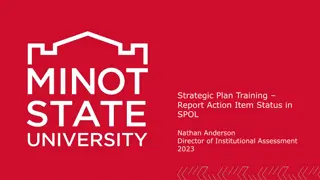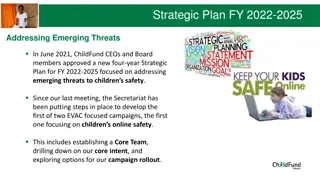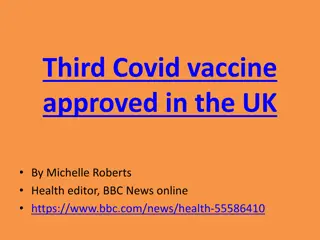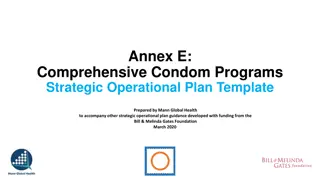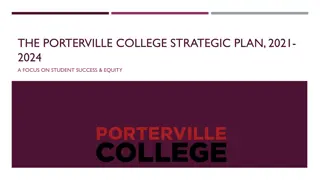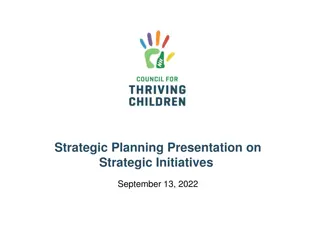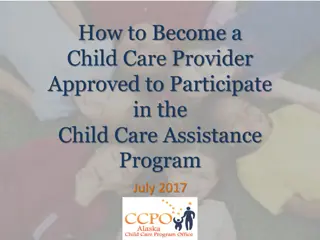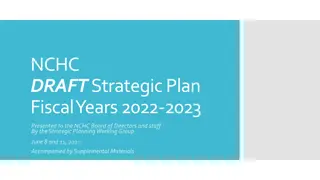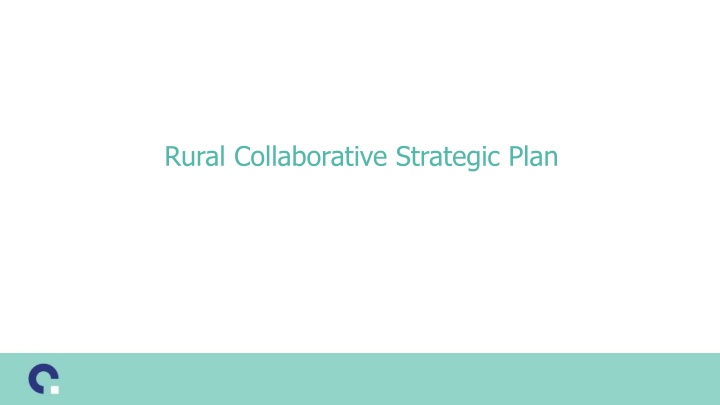
Rural Collaborative Strategic Plan Priorities and Goals
Explore the collaborative strategic plan focusing on clinical quality, financial resilience, and growth objectives. Discover key tactics and performance indicators to drive rural healthcare improvement and financial sustainability.
Download Presentation

Please find below an Image/Link to download the presentation.
The content on the website is provided AS IS for your information and personal use only. It may not be sold, licensed, or shared on other websites without obtaining consent from the author. If you encounter any issues during the download, it is possible that the publisher has removed the file from their server.
You are allowed to download the files provided on this website for personal or commercial use, subject to the condition that they are used lawfully. All files are the property of their respective owners.
The content on the website is provided AS IS for your information and personal use only. It may not be sold, licensed, or shared on other websites without obtaining consent from the author.
E N D
Presentation Transcript
Collaborative Strategic Plan Priorities and Pivots What do we want to prioritize? Is there anything we want to remove? Is there anything we want to add?
Strategic Goal 1. Clinical Quality and Service Objective (by goal) Tactic (by objective) Key Performance Indications (by Strategic Goal) A. Identify common Quadruple AIM metrics that each member will measure and report on quarterly to the Collaborative. Board and clinical committees agree upon a set of Collaborative core metrics to be reported quarterly. Every member reports core metrics. 1. Offer 10 educational trainings or events. 2. Gain consensus on 2 measures to report into the Rural Collaborative Dashboard: 10 Class A members and 3 Class B members report at least one time. B. Adopt a formal process for sharing of best-practice, standardized protocols, policies and procedures. Develop and disseminate a formal process for sharing best practices, standardized protocols, policies and procedures. 3. Create an online resource library for members and Committees. Normalize all committee participants to the new library: 10 Class A members and 3 Class B members log into the library at least one time. Every committee receives and reviews the Collaborative core metrics at each meeting. Identify and coordinate the shared learning and continuing education opportunities.
Strategic Goal 2. Financial Resilience and Growth Objective (by goal) Tactic (by objective) Key Performance Indications (by Strategic Goal) A. Members actively support contracts, programs and services which are offered through the Collaborative. For each Collaborative contract, program or service, report semi-annually to the Board on active participation and financial return. Grow and manage the Collaborative's business portfolio on behalf of our Members. B. Savings to member hospitals increase every year. Use a standardized formula to calculate savings to members for the previous year and distribute individualized savings statements to members annually. 1. Administrative fee revenue is 75% of budgeted 2022 member dues. 2. Enterprise will have its own KPI(s). C. Develop, implement and manage a high-functioning, profit-generating Rural Health Enterprise, LLP (RHE) that enables the Collaborative to offer valuable services and contracts that members want. Implement RHE priorities. Analyze success of Year One priorities. Repeat prioritization process for subsequent years. 3. Total net savings to members attributed to membership in the Collaborative increased by 5% from the previous year. Survey members to determine the priority of potential new products, contracts or services based on the need to cost ratio. Identify 3 priorities. Develop business plans for these priorities. Offer the same survey twice: for years 1-2, and for years 3-5. 4. Class B membership increases from the previous year. 5. 100% of Class A members and at least 50% of Class B members report into Valify. Report RHE performance and compliance regularly to members. D. 2-3 year objective: Initiate a review of the Collaborative governance model to support the expansion of Collaborative offerings. Review membership and agree on one or more of the following: i. Expand Class B membership, ii. Expand or restrict Class A membership, iii. Revise expectations of Class A and Class B membership, iv. Raise or lower dues, v. Invite Class B members to serve on committees
Strategic Goal 3. Creativity Objective (by goal) Tactic (by objective) Key Performance Indications (by Strategic Goal) A. Build the infrastructure to support member's needs for actionable data. Buy or build the infrastructure to gather and integrate actionable data and analyze data. Develop core competencies in exceptional coding practices that support the above activities and result in population health management. B. Identify and assist interested members in forming a value- based transformation "affinity group." Assist members in entering Collaborative-informed value-based contracts. 1. Members participating in the ACO receive shared savings. 2. Attendance of the Rural Collaborative core committees increased by 5% from the previous year. With increasing readiness, assist members in entering into CIN or ACO risk- based arrangements. Evaluate performance and expand in future years. 3. At least five media spotlights mention the Rural Collaborative and five members co-brand with the Rural Collaborative. Survey members to determine the priority of ACO/CIN foundational elements based on the need (value) to cost (monetary and difficulty) ratio. Identify the 3 priorities, assess using the Collaborative Filter. Develop business plans for these priorities. Offer the same survey twice: for years 1-2, and for years 3-5. Develop core competencies in ACO/CIN foundational elements.
Strategic Goal Objective (by goal) Tactic (by objective) Action Step (by tactic) 1. Clinical Quality and Service A. Identify common Quadruple AIM metrics that each member will measure and report on quarterly to the Collaborative. Board and clinical committees agree upon a set of Collaborative core metrics to be reported quarterly. Develop list of potential core metrics. Executive Director presents final list to the Board. Take list to Board, PLC, QI, CFO, and CNE Committees for input. Every member reports core metrics. Collaborative selects a shared reporting platform. Core metrics are loaded into platform; a reporting schedule is identified. Members are trained in how to report in platform. B. Adopt a formal process for sharing of best-practice, standardized protocols, policies and procedures. Develop and disseminate a formal process for sharing best practices, standardized protocols, policies and procedures. Identify a shared learning community platform. Receive a CQIP approval from DOH Train members on platform; continuously orient new members to platform. Create and coordinate a member-access library of best practice policies, procedures, templates and toolkits. Schedule cross-committee gatherings to achieve specific goal(s) and as advised by Collaborative CMO. Offer additional staff and/or technical support to committees Every committee receives and reviews the Collaborative core metrics at each meeting. Dashboard of core metrics is systematically disseminated to all Committees at an expected interval. Committee chair includes core metrics as standing topic on agenda. Identify and coordinate the shared learning and continuing education opportunities. Actively research new opportunities, circulate to appropriate Committee(s) or groups. Track participation
Strategic Goal Objective (by goal) Tactic (by objective) Action Step (by tactic) 2. Financial Resilience and Growth A. Members actively support contracts, programs and services which are offered through the Collaborative. For each Collaborative contract, program or service, report semi-annually to the Board on active participation and financial return. Develop a financial model for determining active support and financial return. Use model to inform decision-making. Grow and manage the Collaborative's business portfolio on behalf of our Members. Continued contracting and developing admin fees, Valify spend metrics and member/committee identified opportunities. Put processes in place to track and continually optimize contract status. Revisit and revise the RC contract approval process from conception through signature and implementation. Onboard new Class B members and identify contract interests. Meet with member's senior leadership to educate about portfolio opportunities Recruit and hire Director of Contract Services. Onboard. Identify short-term contract opportunities and evaluate existing contracts for growth opportunities. Hire a grant writer and develop grant writing program B. Savings to member hospitals increase every year. Use a standardized formula to calculate savings to members for the previous year and distribute individualized savings statements to members annually. Create tool to implement determined formula, showing current years savings and calculation over time. Load data into tool, maintain. Include instructions to ensure longevity. C. Develop, implement and manage a high-functioning, profit- generating Rural Health Enterprise, LLP (RHE) that enables the Collaborative to offer valuable services and contracts that members want. As the RHE grows, the Collaborative will become a larger, more encompassing organization that is supported by a blend of RHE revenue and member dues. The RHE will offer its services to non-members for a fee, and the contribution made by these non-members will contribute to the Collaborative s annual operating budget. Implement RHE priorities. Consult with DZA on RHE tax implications. Identify legal counsel to assist with development of RHE Revisit vision, purpose and goals of RHE with Board, senior staff and legal counsel. Determine key components and complete corporate filings and such Begin development of RHE services per DZA and legal counsel guidelines. Analyze success of Year One priorities. Repeat prioritization process for subsequent years. Determine year one priorities for RHE including assured priorities and "reach" goals. Determine measure of success. Analyze RHE operation against measure of success. Survey members to determine the priority of potential new products, contracts or services based on the need (value) to cost (cost is both $$$$ and How hard would this be? ) ratio. Identify 3 priorities. Develop business plans for these priorities. Offer the same survey twice: for years 1-2, and for years 3-5. Design and circulate survey, analyze results. Report RHE performance and compliance regularly to members. Report results of survey to Board. D. 2-3 year objective: Initiate a review of the Collaborative governance model to support the expansion of Collaborative offerings. Review membership and agree on one or more of the following: i. Expand Class B membership, ii. Expand or restrict Class A membership, iii. Revise expectations of Class A and Class B membership, iv. Raise or lower dues, v. Invite Class B members to serve on committees Present recommendation to Board for approval for 2021. Present recommendation to Board for approval for 2022.
Strategic Goal Objective (by goal) Tactic (by objective) Action Step (by tactic) 3. Creativity A. Build the infrastructure to support member's needs for actionable data. Buy or build the infrastructure to gather and integrate actionable data and analyze data. Pilot ACO population health data model. Partner with one or more health plans to aggregate actionable data for members. Roll out data sharing platform. Research and gain consensus on data infrastructure plan; implement. Develop core competencies in exceptional coding practices that support the above activities and result in population health management. Identify and contract with industry partner to support coding practices. Connect members with available QI resources. Host forums, trainings, brown bag lunches targeted at developing QI core competencies. Identify grant-funded opportunities for QI projects or initiatives; assist in applications. B. Identify and assist interested members in forming a value-based transformation "affinity group." Assist members in entering Collaborative- informed value-based contracts. Recommend Board approve VB readiness committee (possibly RIC) to identify objectives and goals. Educate members on the value of contracting across the membership. Identify and start to address policy-level issues related to health plan contracting Identify Health Plan(s) to partner & develop VB program, data sharing & tracking metrics. With increasing readiness, assist members in entering into CIN or ACO risk-based arrangements. Evaluate performance and expand in future years. Support a ACO steering committee and other subcommittees. Convene stakeholders. Support resource sharing. Vet and endorse an organization to provide ACO support services for the membership Identify and share validated tools to assess gaps in readiness; encourage participation and sharing results. Track, analyze and synthesize state and federal alternative payment models for members. Survey members to determine the priority of ACO/CIN foundational elements based on the need (value) to cost (monetary and difficulty) ratio. Identify the 3 priorities, assess using the Collaborative Filter. Develop business plans for these priorities. Offer the same survey twice: for years 1-2, and for years 3-5. Develop survey, survey members, report back results, reach agreement. Develop core competencies in ACO/CIN foundational elements. On an ongoing basis, survey other rural organizations nationally to identify innovative programs, services and best practices to take the Collaborative product offerings and benchmarking to the next level.

